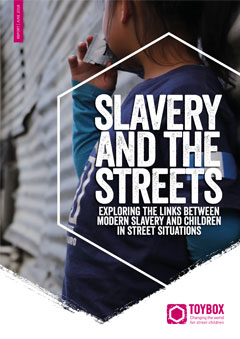Publication Summary
One in four people exploited in modern slavery are children. These ten million children are trafficked and recruited into exploitative labour, forced into the sex trade, or into working for gangs. Modern Slavery characteristics, such as trafficking, exploitative labour and sexual exploitation, are some of the everyday experiences of children in street situations.
This report explores drivers of modern slavery and street children and finds that the drivers are overwhelmingly the same. It is clear that addressing these drivers will reduce the vulnerability of children to modern slavery, and consequentially its prevalence.
Due to poverty and inequalities children who are forced into work are more at risk of the worst forms of labour and excluded from education as a result of their need to earn an income. Street connected children are also often forced to work, including in the worst forms, and frequently are excluded from school. Violence, abuse, exploitation and neglect are too often the experience that children trapped in modern slavery have. However, these same things both cause children to leave homes and move to the streets as well as being what they experience once in the streets. Children on the move are particularly vulnerable to modern slavery, especially those unaccompanied and separated children. Children end up being street-connected as a result of being trafficked, escaping conflict or migrating with or without family members within and across boarders looking for work.
The report concludes that by addressing street-connectedness, we will also be addressing modern slavery, especially as street-connected children and their issues is often hidden. It is recommended that organisations and donors adopt broader view of modern slavery to include street-connected children, if we are to have a significant impact on reducing modern slavery and reaching the SDGs.
